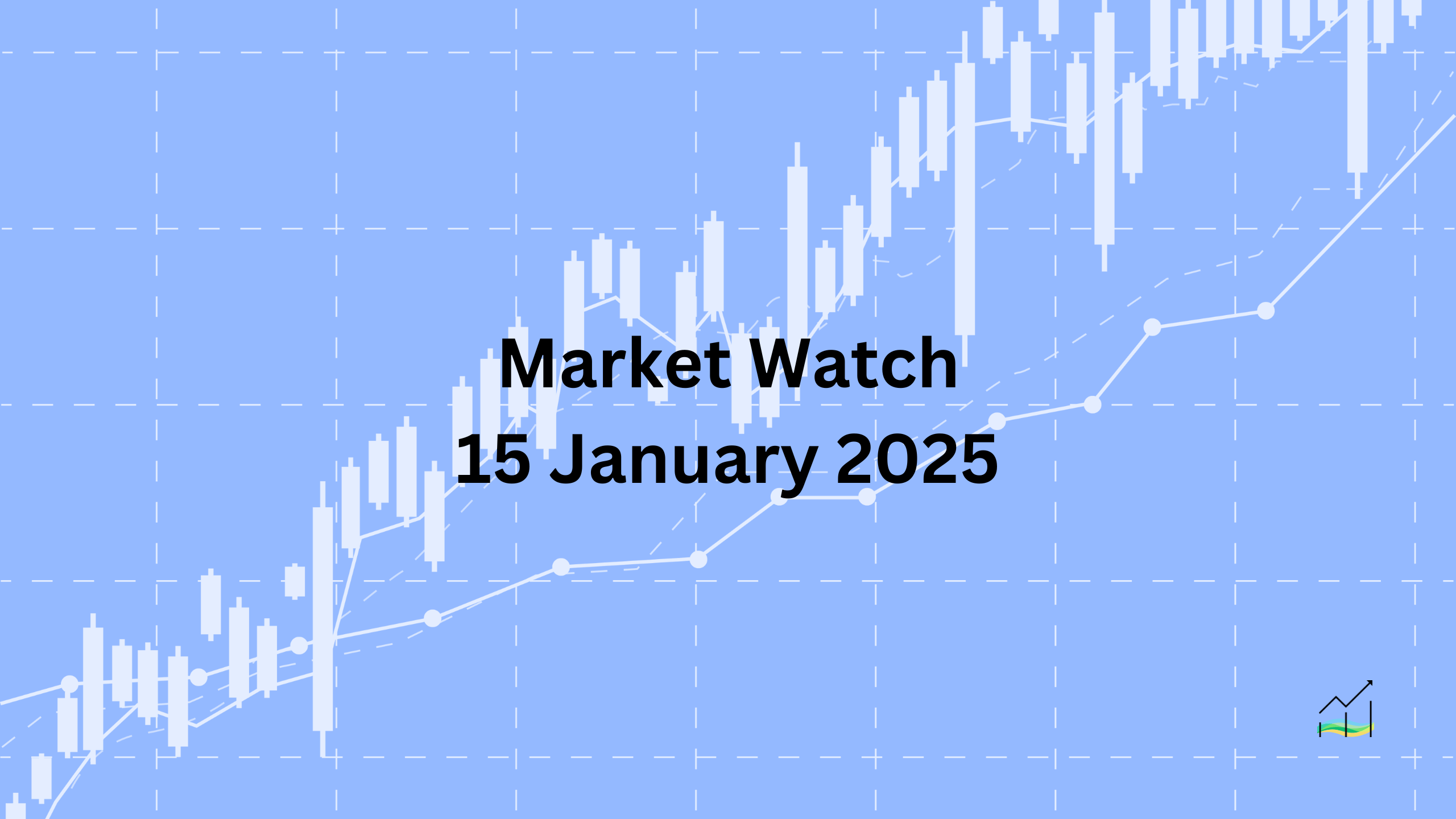15/01/2025 Market Watch

Market Watch: U.S. Dollar Exhibits Softness, Yen Surge
The US dollar remains relatively steady against the G10 currencies but shows some softness. Remarks by Bank of Japan Governor Ueda emphasized the importance of this month's meeting, propelling the yen to its highest level since January 6. Meanwhile, UK consumer prices came in weaker than anticipated, potentially skewed by the timing of data collection. Despite this, the pound is holding firm, and UK Gilts have seen a rally. North America's attention today turns to the CPI, following yesterday's slightly softer-than-expected PPI. However, key components contributing to the PCE deflator were firm.
Equity markets are generally higher, though mixed in the Asia-Pacific region, with losses in China, South Korea, Taiwan, and Australia. Europe’s Stoxx 600 is attempting to break a three-day losing streak, while US index futures show strength. European 10-year yields mostly fell by 3-5 basis points, with UK Gilts leading with an eight basis point decline. The US 10-year Treasury yield has softened slightly to 4.77%.
Gold is nearing this week's high of $2695, close to its yearly peak of $2698. It hasn't surpassed $2700 since December 12. Crude oil’s strong momentum paused on Monday, with February WTI just above $79.25. It has since consolidated, pulling back to around $77.25 today.
United States of America
It is unlikely that last week's December jobs data, yesterday's PPI, or today's CPI will significantly influence the Federal Reserve's decisions later this year. However, markets believe there is enough economic momentum to justify 32 basis points of easing this year, down from the 43 basis points anticipated at the end of last year. Consumer prices are expected to have risen by 0.4% last month, resulting in a 2.9% year-over-year increase, up from 2.7% in November. Core CPI is projected to have increased by 0.2% to 0.3%, potentially keeping the annual rate steady at 3.3%.
The Beige Book, which has gained importance under Chair Powell, is due today. Despite its elevated role, it may not attract much attention as significant policy shifts are unlikely. Meanwhile, tomorrow's confirmation hearings for the Treasury Secretary nominee could provide insight into the new administration’s economic policies. Discussions have centered around the potential for tariffs, with implementation possibly occurring in stages. It remains uncertain how much authority will be delegated to the Cabinet versus retained within the White House.
Key Points:
- Markets anticipate 32 basis points of easing this year.
- December's CPI expected to rise 0.4%, year-over-year at 2.9%.
- Core CPI likely steady at 3.3%.
- Beige Book may have limited impact despite its importance.
- Treasury Secretary confirmation hearings could clarify tariff policies.
- Dollar Index shows support near 108.50-65, resistance above 109.30-40.
Australia
The Australian dollar's recovery from its lowest level since the Covid-19 pandemic (~$0.6130) on Monday was short-lived, as it struggled to sustain gains above $0.6200 yesterday. Today, it edged up slightly, testing the 20-day moving average and the 50% retracement level of last week's losses, around $0.6215. Notably, the Australian dollar has not closed above its 20-day moving average since November 7, shortly after the US election, when the Federal Reserve cut its funds target rate by 25 basis points.
Australia's upcoming December jobs report will be closely watched, with the nation having added nearly 394,000 jobs through November 2024, compared to around 432,000 during the same period in 2023. Full-time positions accounted for almost 336,000 of these jobs in 2024, significantly higher than the 209,000 recorded from January to November 2023. The unemployment rate hovered between 3.9% and 4.1% last year, potentially ending 2024 at 4.0%, slightly above December 2023's 3.9%. The participation rate is also expected to have risen from 66.6% at the end of 2023 to 67.0% by the end of 2024.
Key Points:
- Australian dollar tested resistance near $0.6215 after a recent low of ~$0.6130.
- Struggled to close above the 20-day moving average since early November.
- December jobs report awaited, with 394k jobs added through November 2024.
- Full-time job growth significantly higher in 2024 compared to 2023.
- Unemployment rate expected around 4.0%, with participation rate at 67.0%.
Canada
The US dollar has continued trading in a narrow range against the Canadian dollar, staying between CAD1.4280 and CAD1.4450 since January 6. This sideways movement aligns with a seven-day decline in the US two-year yield premium over Canada, which has narrowed from nearly 137 basis points on January 6 to around 120 basis points yesterday, the smallest spread in a month.
Today, Canada will release November manufacturing and wholesale sales data, though these reports rarely impact the market. More attention may focus on December's existing home sales, which saw their first decline since July after rising nearly 15% over the previous four months. The probability of a rate cut this month has decreased from nearly 80% at the end of last year to less than 65% now. The swaps market currently prices in 47 basis points of cuts for the year, down by about 17 basis points compared to the end of 2024.
Key Points:
- USD/CAD remains in a narrow range between CAD1.4280 and CAD1.4450.
- US-Canada two-year yield spread narrowed to 120 basis points.
- Canadian November manufacturing and wholesale sales due today.
- December existing home sales declined, drawing market attention.
- Rate cut odds for this month reduced from nearly 80% to below 65%.
- Swaps market anticipates 47 basis points of cuts this year.
China
The People's Bank of China (PBOC) has tightened liquidity in both Hong Kong and mainland China to stabilize the yuan, which remains near the lower limit of its 2% trading band against the US dollar. Last weekend, the dollar nearly reached CNY7.3330 but has stayed below CNY7.3320 this week. With the upcoming US inauguration and potential tariff threats, there is little motivation to buy the yuan, and ongoing consolidation appears likely.
For the past two weeks, the dollar has been confined within the range set on December 31 against the offshore yuan (~CNH7.3055-CNH7.37). Some speculate that China is allowing the yuan to trade on the lower end to signal its willingness to depreciate if tariffs are increased. However, this perspective seems ideologically driven. Since the US election, the yuan has depreciated by approximately 3.1%, while the euro has dropped 5.7%, sterling 6.4%, and the yen 4%. This suggests no specific signaling from China regarding tariffs. Instead, Chinese authorities have intervened to temper the dollar's rise against the yuan, even though a broader dollar increase could occur if tariff threats materialize, potentially impacting China more than other nations.
Key Points:
- PBOC tightens liquidity to stabilize the yuan near its lower trading band.
- Dollar remained below CNY7.3320 this week amid upcoming US policy changes.
- Speculation about yuan depreciation as a tariff signal appears unfounded.
- Yuan down 3.1% since US election; euro, sterling, and yen also depreciated.
- Chinese officials aim to moderate the dollar's gains against the yuan.
Europe
The euro extended its recovery, reaching nearly $1.0310 yesterday, just shy of the 50% retracement of its decline from the January 6 high above $1.0435. It has since edged slightly above $1.0315, with the next target in the $1.0335-$1.0350 range. On the downside, a break below $1.0250 could lead to a move back toward $1.0200, coinciding with the expiration of large options today (2.2 billion euros) and Friday (2.5 billion euros). Notably, options expiring at $1.03 are also substantial, with 1.1 billion euros today and 2.7 billion euros on Friday.
Earlier today, the eurozone reported a 0.2% increase in November industrial output, supported by better-than-expected industrial production figures from Germany (up 1.5%) and France (up 0.2%). Italy also showed a 0.3% rise, exceeding forecasts, while Spain disappointed with a 0.8% decline. The Bundesbank's estimate of a 0.2% contraction in Germany's economy last year follows a 0.3% decline in 2023, indicating potential stagnation or a slight contraction in Q4.
Key Points:
- Euro extended recovery to above $1.0315, next target $1.0335-$1.0350.
- Break below $1.0250 could trigger a move toward $1.0200.
- Large option expirations at $1.03 and $1.0200 today and Friday.
- Eurozone industrial output rose by 0.2% in November, with strong German and French contributions.
- Bundesbank estimates a 0.2% contraction in Germany’s economy for the last year.
Japan
Comments from Bank of Japan (BOJ) Governor Ueda, following his deputy’s remarks, highlighted that a rate hike is being considered later this month. Ueda expressed optimism about the upcoming wage round, which further boosted market sentiment. As a result, the swaps market adjusted its expectations, increasing the likelihood of a rate hike, and the yen strengthened in the forex market. The dollar has been sold down to nearly JPY156.70 today, its lowest level since January 6, when it touched JPY156.25. There are options for $1.8 billion at JPY157 expiring this Friday. Recently, the dollar has traded on both sides of the 20-day moving average, which is near JPY157.50 today, but has not closed below it in over a month. A break below JPY156 could lead to a move toward JPY155.
Key Points:
- BOJ Governor Ueda’s comments raised expectations for a rate hike.
- The yen strengthened, with the dollar dropping to near JPY156.70.
- $1.8 billion in options at JPY157 expire on Friday.
- The dollar has stayed above the 20-day moving average for over a month.
- A break below JPY156 could push the dollar toward JPY155.
United Kingdom
Sterling's recent bounce stalled yesterday at $1.2250, just below the five-day moving average and short of the 38.2% retracement level from its recent decline (from around $1.2575 on January 7). The currency remains below that level today, although slightly. There are options for almost GBP705 million at $1.2275 expiring in a few hours, but their relevance seems diminished compared to yesterday.
The UK’s December CPI report showed a slightly softer-than-expected increase. The Office for National Statistics (ONS) collected data earlier than usual, missing the holiday-related rise in airfares, which may have lowered consumer inflation by just over 0.1%. The headline inflation rose by 0.3% (instead of the expected 0.4%), and the year-over-year rate eased to 2.5% from 2.6%. Core inflation and service prices moderated as well. Core CPI fell to 3.2% (from 3.5%) and services slowed to 4.4% (from 5.0%). Deflation in producer prices appears to be subsiding. Markets are now more confident in a Bank of England rate cut next month, with the odds nearing 90%, up from around 66% at the end of last year. The market is pricing in about 52 basis points of cuts this year, slightly down from 60 basis points at the end of 2024. Meanwhile, the 10-year Gilt yield continues to consolidate within last Thursday's range (~4.78%-4.92%), with the GBP4 billion 10-year Gilt sale today being easily absorbed, though the bid-cover ratio of 2.8 was the lowest since September 2023.
Key Points:
- Sterling's bounce stalled near $1.2250, below the 38.2% retracement level.
- Options at $1.2275 expiring today have reduced significance.
- December CPI was slightly softer, with headline inflation at 2.5%.
- Core and service inflation moderated, while producer price deflation is subsiding.
- Market expectations of a Bank of England rate cut have risen to 90%.
- The 10-year Gilt yield remains within last Thursday's range, with a successful Gilt sale but a lower bid-cover ratio.
© 2025 SKONE Enterprise (003319453-V). All rights reserved.
The content on this site is for informational purposes only and does not constitute financial advice.


